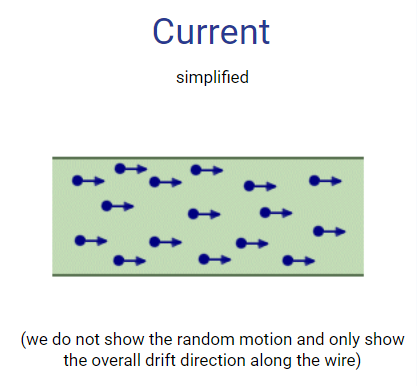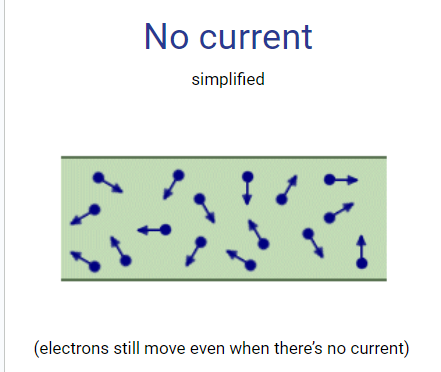CH14 p.d, emf, current, resistance AYr1
1/24
Earn XP
Description and Tags
Definitions of p.d, emf, current, resistance, resistivity, and theory behind super and semi-conductors. CH14 in my textbook.
Name | Mastery | Learn | Test | Matching | Spaced |
|---|
No study sessions yet.
25 Terms
What is a charge carrier?
a particle that is charged
What is meant by electric current?
rate of flow of charge
amount of chagre charge flowing in 1s through a cross-sectional area (of a wire)
Q = N x qe
any amount of charge in the universe is equal to the charge of the electron times an integer
Good conductor definition
a material that has many delocalised electrons
Current in terms of electron drift
electrons have partially random movement and an overall drift in one direction

No current in terms of electron drift
electrons have completely random movement collectively cancelling each other out (no net current flow)

What is meant by the potential difference?
amount of energy transferred per unit of charge (per coulomb)
V = W/Q
difference between two terminals (ends)
What is the electromotive force (EMF)?
amount of energy produced by a cell, including lost volts
amount of energy that is transferred from chemical energy to electrical energy per unit charge (per 1C of charge)
What are lost volts?
volts in a battery that are lost due to internal resistance of the cell (e.g. through heat)
Power
amount of energy transferred per second
P = IV (of component)
number of volts transferred to the component by the current (per second)
rate of energy transfer to component
P = I x EMF (of the cell)
how many joules the cell produces
rate of energy production
P = I (cell) x V (terminal)
number of volts transferred to the circuit by the current (per second)
rate of energy transfer to the circuit
What is meant by the resistance of a component?
ratio of p.d across the terminals of component over the current flowing through it
(energy in V lost to component divided by the current flowing through it)
R = V/I where V is the energy lost to component
What are the factors affecting resistance of a component?
length (directly proportional to R)
Resistivity - temp and material (directly proportional to R)
Cross-sectional area (indirectly proportional to R)
What is a superconductor?
A material whose resistivity drops to 0Ωm at temperatures lower than the critical temperature
What is the critical temperature?
The temperature at which the resistivity of a superconducting material falls to 0Ωm
What is a semiconductor?
materials whose resistivity decreases with increased temperature
What is the resistivity?
The electrical resistance of a conductor of unit cross-sectional area and unit length.
What can resistivity be used to determine?
To evaluate materials on their ability to conduct electric current
High resistivity = poor conductors
Low resistivity = good conductors
What are some of the applications of superconductors?
Power cables; they reduce energy loss through heating when transmitting electric current.
They produce strong magnetic fields, so are used in MRI machines, electromagnets in the LHC (CERN), motors and generators,
Magnetic fields; maglev trains, create a magnetic field strong enough to magnetically levitate a train
What is the effect of using a superconductor over other metals?
They have zero resistivity, therefore do not heat up due to resistance, which means energy is saved.
They can carry higher currents through a smaller area, so the coils or material needed is much thinner and lighter. (This also improves efficiency)
Does length of the wire affect resistivity?
No, as the length of the wire increases, the resistance of the wire increases proportionally as they are directly proportional. Therefore the resistivity remains the same overall.
Current node law.
The sum of currents flowing into a node equals the sum of the currents flowing out.
Law for nodes
The sum of currents flowing into a node equals the sum of the currents flowing out.